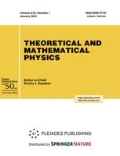Abstract
We study properties of the space \(\boldsymbol{\Omega}\) of solutions of a special double confluent Heun equation closely related to the model of a overdamped Josephson junction. We describe operators acting on \(\boldsymbol{\Omega}\) and relations in the algebra \(\mathcal{A}\) generated by them over the real number field. The structure of \(\mathcal{A}\) depends on parameters. We give conditions under which \(\mathcal{A}\) is isomorphic to a group algebra and describe two corresponding group structures.
Similar content being viewed by others
REFERENCES
S. Yu. Slavyanov and W. Lay, it Special Functions: A Unified Theory Based on Singularities, Oxford Univ. Press, Oxford (2000).
D. Schmidt and G. Wolf, “Double confluent Heun equation,” it Heun’s Differential Equations (A. Ronveaux, ed.), Oxford Univ. Press, Oxford (1995), pp. 129–188.
M. Hortaçsu, “Heun functions and some of their applications in physics,” Adv. High Energy Phys., 2018, 8621573 (2018); arXiv:1101.0471v11 [math-ph] (2011).
The Heun Project, it Heun Functions, Their Generalizations and Applications, Website http://theheunproject.org/bibliography.html (2019).
V. M. Buchstaber and S. I. Tertychnyi, “Automorphisms of the solution spaces of special double-confluent Heun equations,” Funct. Anal. Appl., 50, 176–192 (2016).
S. I. Tertychnyi, “Solution space monodromy of a special double confluent Heun equation and its applications,” Theor. Math. Phys., 201, 1426–1441 (2019).
T. Panov and Ya. Veryovkin, “On the commutator subgroup of a right-angled Artin group,” J. Algebra, 521, 284–298 (2019).
Funding
This research was supported in part by the Russian Foundation for Basic Research (Grant No. 17-01-00192).
Author information
Authors and Affiliations
Corresponding author
Ethics declarations
The authors declare no conflicts of interest.
A. Necessary information about $$\mathfrak{pqrs}$$ polynomials
We consider sequences \(\{p_k\}\), \(\{q_k\}\), \(\{r_k\}\), and \(\{s_k\}\), \(k=0,1,2,\dots\), of functions of the complex variable \(z\) defined by the recursive scheme
Here, we need only one set of four polynomials (representatives of the sequences defined above), namely, the functions with the index \(k=\ell\). For them, we introduce the notation
For the first few values of \(\ell\), the \(\mathfrak{pqrs}\) polynomials have the forms
The \(\mathfrak{pqrs}\) polynomials satisfy the system of linear differential equations
As a consequence of the \(z\)-independence, we can calculate the value of \(\mathcal{D}_\ell\) for any value of this variable except zero. In particular,
Substituting \(z=1\) in the last four equalities, we obtain
B. Group properties of transformations generated by $$\mathcal{L}$$ -operators for $$\lambda+\mu^2>0$$
We interpreted the constant \(\omega \) introduced in formulas (3) as an arbitrary nonzero real number. Its role consists in a “synchronous scaling” of the operators \(\mathcal{L}_{\mathrm{B}}\) and \(\mathcal{L}_{\mathrm{C}}\), and \(\omega\) can be fixed in any desired way, as needed. It follows from formulas (6)–(14) that the useful effect simplifying their form is obtained if \(\omega\) is chosen from the condition \(|(2\omega)^2(\lambda+\mu^2)|=1\). More precisely, depending on the values of \(\lambda\) and \(\mu\), we obtain either \((2\omega)^2 (\lambda+\mu^2)=1\) or \((2\omega)^2(\lambda+\mu^2)=-1\). We considered the first case in the main text, and we therefore focus on the second case here. It corresponds to the domain in the space of the parameters \(\lambda\) and \(\mu\) such that
A second simplification is achieved by leveling the constant \(\mathcal{D}_\ell\). In contrast to \(\omega\), this is an invariant, a particular (polynomial) function of the parameters \(\lambda\) and \(\mu\) (see Appendix A). But we can perform a specific normalization of the operators \(\mathcal{L}_{\mathrm{A}}\) and \(\mathcal{L}_{\mathrm{B}}\), multiplying them by \(\mathcal{D}_\ell^{-1/2}\) for \(\mathcal{D}_\ell>0\) or by \((-\mathcal{D}_\ell)^{-1/2}\) for \(\mathcal{D}_\ell<0\). Only the sign of \(\mathcal{D}_\ell\) then remains. This allows simplifying rules (57) as follows.
If \(\mathcal{D}_\ell>0\), then we define
It follows from an analysis of tables (60) that there exist two groups, each containing the subgroup \(\mathbb{Z}\) generated by the monodromy operator \(\mathcal{M}\) as a normal divisor. These groups will be described in a subsequent paper. In conclusion, we note that the quotient group by this normal divisor is the quaternion group for \(\mathcal{D}_\ell>0\) and the dihedral group for \(\mathcal{D}_\ell<0\).
Rights and permissions
About this article
Cite this article
Buchstaber, V.M., Tertychnyi, S.I. Group algebras acting on the space of solutions of a special double confluent Heun equation. Theor Math Phys 204, 967–983 (2020). https://doi.org/10.1134/S0040577920080012
Received:
Revised:
Accepted:
Published:
Issue Date:
DOI: https://doi.org/10.1134/S0040577920080012


